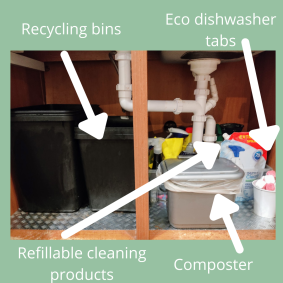Our journey towards becoming a more eco-friendly household
November 2021
In the UK, we have an abundance of choice when it comes to shopping, especially food.
In 2016, a typical Tesco Superstore stocked around 40,000 product lines, of which 25,000 were food and beverages*. Aldi and Lidl generally stock between 1500 and 2000 different products.
For some years now, our family has chosen to shop in the smaller supermarkets. We find we spend less time and energy making decisions as we walk the limited aisles. We also generally spend less money and return with fewer items than when we drop in on the bigger stores. This not only reduces the amount of storage capacity we need in our kitchen, but it means the organisation and management of this busy space is a little simpler.
Choosing an environmentally conscious lifestyle can be a daunting prospect. Our family is working towards becoming a more eco-friendly household, but alongside all the busyness of life, it can be slow progress.
To help you consider your eco journey, here are the things we’ve adjusted in our family kitchen, illustrated by the 6 R’s of a greener, cleaner, clutter free kitchen. We hope they inspire and encourage you as you find what works best for you and your household.
-
Reminding
We use a freezer inventory on the front of our freezer door to remind us what’s inside. It’s a wipe clean list and is great for meal planning and avoiding last minute trips to the local shops. Our food shopping list is also part of a magnetic family organiser on the front of the fridge and we take a photograph of it when we head to the shops so we don’t forget anything.
-
Reusing
We love a takeaway treat in our family and we always reuse the containers for batch cooking to provide weekday meals in the freezer. They’re the perfect size for a one or two person portion and removable freezer labels make it easy to identify what’s inside (is it chilli or bolognaise?!). They’re also brilliant for storing bits and bobs in drawers to help contain and identify them. I use them with my clients all the time for stationery, small utensils or mini toys.
Foil, parchment, jars and plastic bags can also all be reused within the kitchen and home. Glass jars make great mini vases and parchment can line baking trays several times over.
We’ve also switched to washable kitchen cloths and bamboo and sugar cane kitchen towels. They’re more environmentally friendly than less durable or disposable ones, but just as good quality.
-
Recycling
We’ve organised our under sink cupboard so that two bins fit underneath for easy and quick capture of kitchen recyclables. We also have a carrier bag on a hook to collect plastic recycling for the M&S soft plastics scheme which operates in their stores for plastic bags and wrappers.
You can even pay to have a plastic recycling box at home to collect any plastics not easily recycled locally or from your kerbside. The box is collected and processed by Reworked and the contents are responsibly recycled.
-
Reducing
To eliminate plastic milk bottles, we switched to a glass bottle milk delivery with Milk & More. The bottles are reused and you can even add other tasty items to your delivery at late notice (continental breakfast is a family favourite).
Plastic free storage containers are more readily available than ever before and there are great quality products to choose from on the market. Lakeland has a plastic alternative range and is always my go to place for a useful substitute. Beeswax wraps and silicone bags replace cling film and zip bags; whilst paper straws have replaced their plastic counterparts and canvas bags make great vegetable storage bags.
We keep a bag of bags in the boot of our car for food shopping so that we can reuse them frequently. When they are on their last legs we turn them into bin liners for our household waste baskets. We also look for loose fresh produce in our shops so we can use our netted vegetable bags and avoid packaged produce.
-
Refilling
Refill shops are increasingly arriving on our high streets - we’ve just got one in Surbiton although I haven’t visited yet. Take your own bottle or rent a bottle to fill with food, laundry, cleaning, bathroom and beauty products. They’ll even deliver like the milkman, swapping your empty bottle for a full one.
There are also postal services such as Smol, providing both convenience and an eco conscious solution. We’ve switched to their postal laundry tablets which reduce packaging, storage space, chemicals and cost.
Decanting bulk products into smaller containers is another way to reduce packaging and storage space. For example, we’re experimenting with buying larger bottles of environmentally friendly Method cleaning products and topping up the same spray bottle to reuse rather than replace.
Of course, there’s always the option of making your own cleaning products. I tried my hand at this with sanitizer when Covid first struck. It worked really well and produced a pleasant and effective lavender alcohol rub. Raiding your kitchen for baking soda, vinegar and lemon is a sure way to create an effective, eco-friendly product.
-
Running
Last up is something we’ve only just started trying and that’s using the eco mode on our dishwasher. It’s a 3hr 20 setting but when it runs at full capacity overnight it doesn’t matter how long it takes. It significantly cuts our electricity and water consumption and many of our kitchen appliances have now advanced to run eco modes like this to reduce our carbon footprint.
Over to you
I love organising kitchens. We often spend so much time in them - cooking, dishwashing, cleaning, working, socialising, eating. When they work efficiently, they are a joy to spend time in and when they’re also eco-friendly there’s a huge satisfaction about knowing you’re playing your part to protect our incredible world. It requires personal effort and sometimes trial and error to find what works best for you, but a little adjustment on our part can really make a big difference to the global picture.
What will you do differently in your kitchen?
*2016 USDA Foreign Agricultural Service GAIN report



